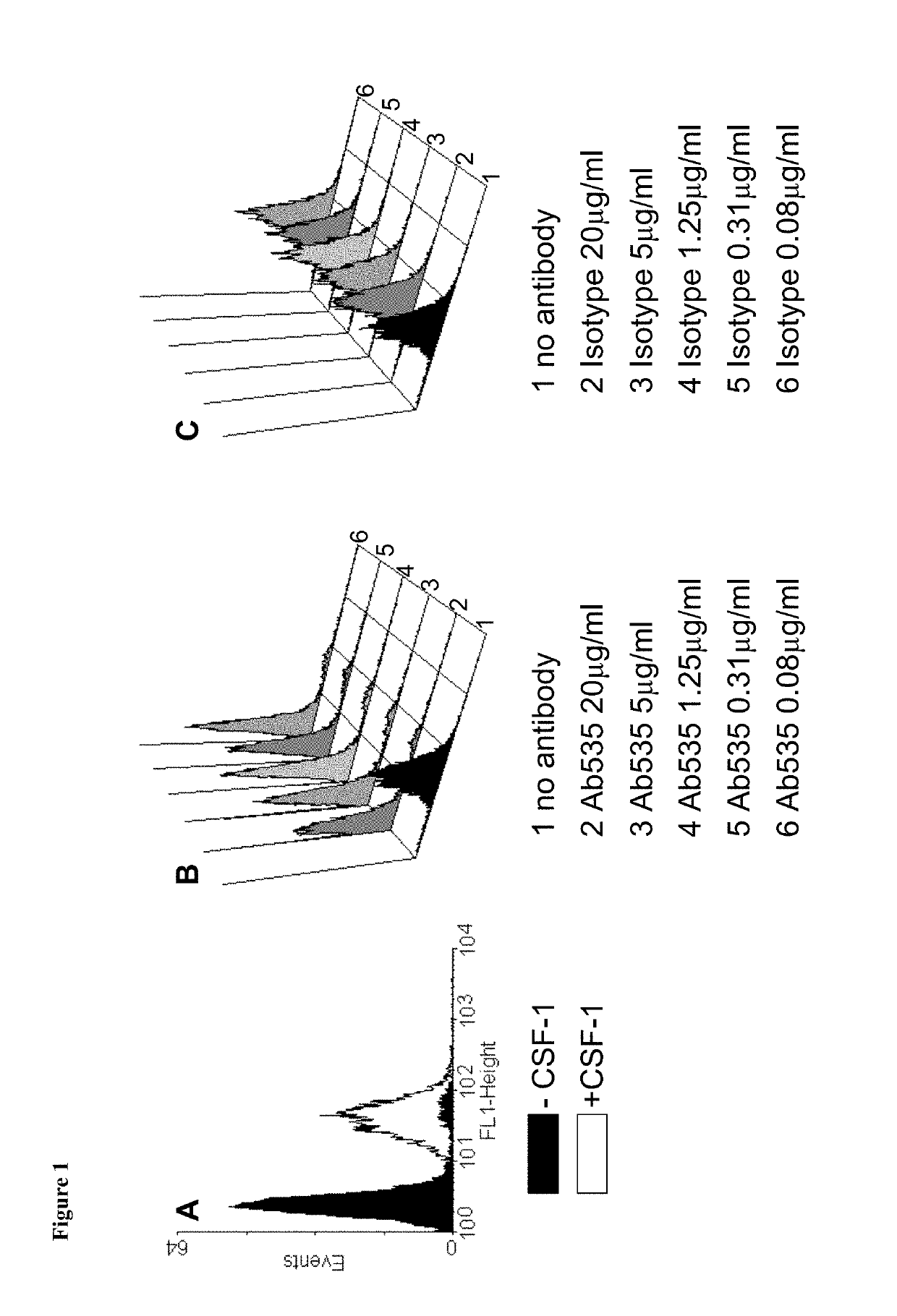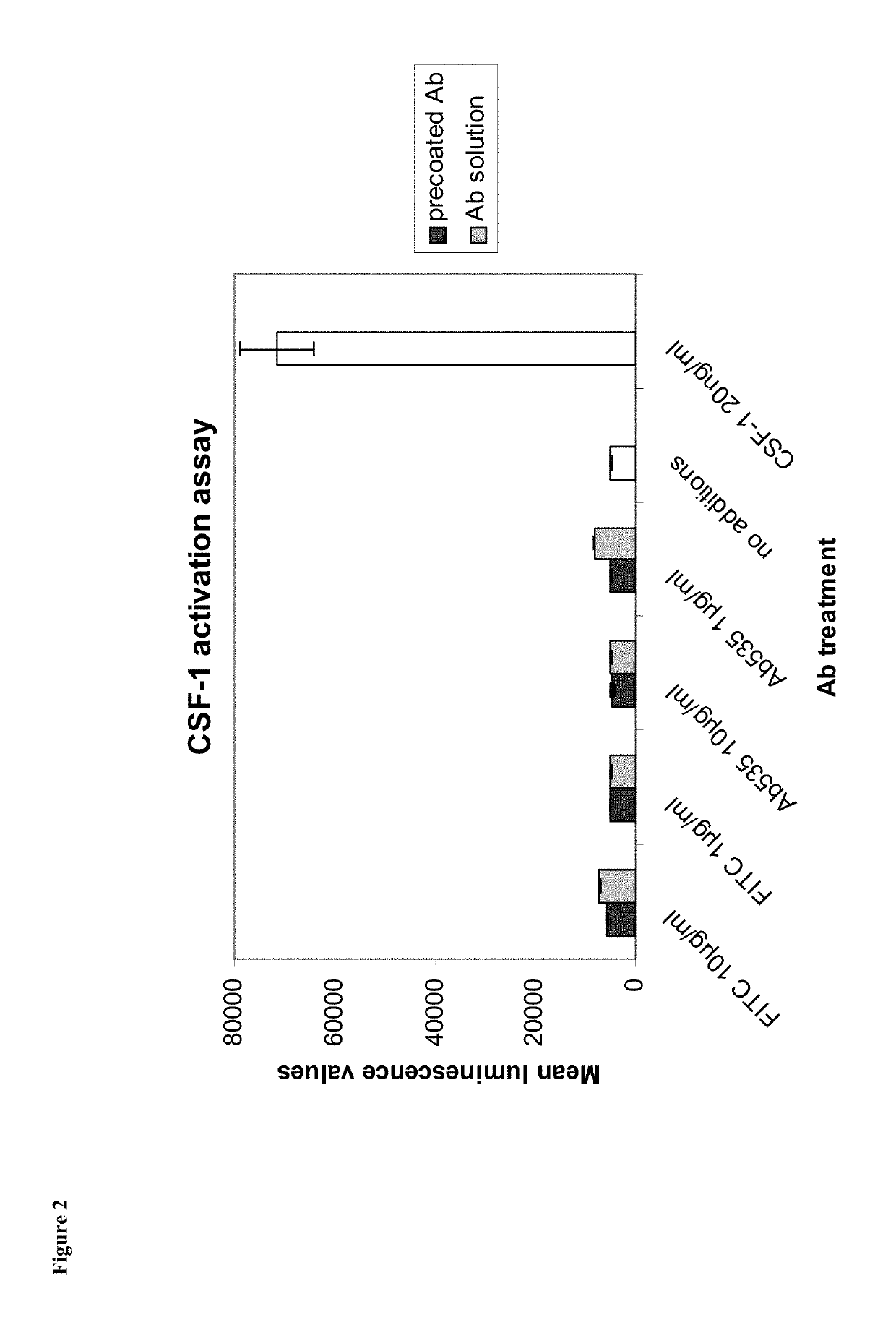Method for the treatment of epilepsy, epileptogenesis, seizures or convulsions by an anti-colony-stimulating factor 1 receptor (CSF-1R) antibody
an anti-colonystimulating factor and epilepsy technology, applied in the field of epilepsy, epileptogenesis, seizures or convulsions by anti-colonystimulating factor 1 receptor (csf1r) antibodies, can solve the problems of increased chance of future seizures, abnormal, excessive or hypersynchronous neuronal activity in the brain, etc., to achieve the effect of modulating the function of microglia and facilitating the treatment and/or prophylaxis of neuro
- Summary
- Abstract
- Description
- Claims
- Application Information
AI Technical Summary
Benefits of technology
Problems solved by technology
Method used
Image
Examples
example 1
ISOLATION OF AN ANTI-MOUSE CSF-1R ANTIBODY
[0206]2 rabbits received 5 immunisations with cells transiently expressing residues 1-512 of mouse CSF-1R (Uniprot Entry p09581). Antibody response was monitored in an ELISA using Nunc Maxisorp plates coated with 2 μg / ml mouse CSF-1R-Rabbit Fc. Sera titres out to 1:100,000 dilution were observed with both rabbits. Binding of sera to M-NFS-60 cells (Metcalf et al., 1970) was also determined by FACS. Median FL1 was plotted against antibody dilution. Binding out to a dilution of 1:10,000 was observed.
[0207]Using the CSF-1-dependent M-NFS-60 cell line (Metcalf et al., 1970), it was shown that sera from both rabbits could block CSF-1-dependent cell survival out to a dilution of 1:100 (data not shown).
[0208]One hundred 96-well plates were seeded with 1000-5000 rabbit PBMCs per well and grown for 1 week at 37 C in the presence of EL4-B5 mouse thymoma cells and rabbit T cell conditioned media (TSN). Antibody-containing supernatants were then screene...
example 2
IN VITRO ANALYSIS OF AB535
Ab535 Blocks Binding of Murine CSF-1 to CSF-1 Receptor-Positive Cell Lines In Vitro
[0215]The capacity of receptor-bound Ab535 to prevent CSF-1 from binding to CSF-1R was investigated. A murine CSF-1R-positive cell line, M-NFS-60, was used in assay in which cells were pre-incubated with Ab535 or a control antibody prior to exposure to CSF-1. Receptor-bound CSF-1 was then detected using a fluorescently-labelled antibody and flow cytometry. An Ab535-dependent decrease in cell fluorescence intensity was interpreted as indicating a capacity of receptor-bound Ab535 to prevent the binding of CSF-1 to CSF-1R.
[0216]M-NFS-60 cells (LGC Promochem, Teddington, UK) were maintained in suspension in basal RPMI medium (Invitrogen) supplemented with 10% fetal calf serum (PAA), Hepes (Invitrogen, 10 mM final concentration), Sodium Pyruvate (Invitrogen, 1 mM final concentration) Glucose (Sigma-Aldrich, 4.5 g / l final concentration), Sodium bicarbonate (Sigma-Aldrich, 1.5% fina...
example 3
NE MOUSE MODEL OF TEMPORAL LOBE EPILEPSY
[0224]The pilocarpine model of temporal lobe epilepsy and epileptogenesis was performed as described by Mazzuferi et al., 2012. Naïve or epileptic mice (n=8-10) 19 weeks after induction of temporal lobe epilepsy by pilocarpine where administered 100 mg / kg (s.c.) anti-CSF-1R (Ab535) or vehicle on day 1 and 4 of experiment. On day 8, animals were sacrificed and their brains were removed from the skull.
[0225]Pilocarpine-induced temporal lobe epilepsy is associated with symmetrical changes in both brain hemispheres (Mazzuferi et al., 2012). The hippocampus was rapidly dissected form the right-side hemisphere and frozen at −80° C. to perform RNA extraction an qRT-PCR. The left-side hemisphere was fixed by immersion in 4% PFA in order to perform histological studies (immunohistochemistry).
[0226]In order to show molecular consequences of receptor blocking by the antibody, downstream transcriptional target genes of CSF-1R were identified using Thomson...
PUM
| Property | Measurement | Unit |
|---|---|---|
| molecular weight | aaaaa | aaaaa |
| molecular weight | aaaaa | aaaaa |
| molecular weight | aaaaa | aaaaa |
Abstract
Description
Claims
Application Information
 Login to View More
Login to View More - R&D
- Intellectual Property
- Life Sciences
- Materials
- Tech Scout
- Unparalleled Data Quality
- Higher Quality Content
- 60% Fewer Hallucinations
Browse by: Latest US Patents, China's latest patents, Technical Efficacy Thesaurus, Application Domain, Technology Topic, Popular Technical Reports.
© 2025 PatSnap. All rights reserved.Legal|Privacy policy|Modern Slavery Act Transparency Statement|Sitemap|About US| Contact US: help@patsnap.com



